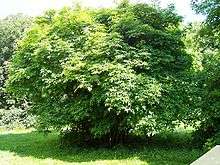Staphylea
Staphylea, called bladdernuts,[1] is a small genus of 10 or 11 species of flowering plants in the family Staphyleaceae, native to temperate regions of the Northern Hemisphere. The highest species diversity is in China, where four species occur.
| Staphylea | |
|---|---|
 | |
| Staphylea colchica | |
| Scientific classification | |
| Kingdom: | Plantae |
| Clade: | Tracheophytes |
| Clade: | Angiosperms |
| Clade: | Eudicots |
| Clade: | Rosids |
| Order: | Crossosomatales |
| Family: | Staphyleaceae |
| Genus: | Staphylea L. |
| Species | |
|
See text | |
They are large shrubs, occasionally small trees, growing to 2–5 m tall. The leaves are deciduous, arranged in opposite pairs, and pinnate, usually with three leaflets, but 76–178 mm (3–7 in) S. pinnata and 76–127 mm (3–5 in) S. colchica. The flowers are produced in drooping terminal panicles 5–10 cm long, with 5–15 flowers on each panicle; the individual flowers are about 1 cm long, with the five sepals and petals similar in size and in their white or pale pink colour. The fruit is an inflated papery two- or three-lobed capsule 3–10 cm long, containing a few small nut-like seeds.
Species
- Staphylea bolanderi – Sierra bladdernut. Western North America.
- Staphylea bumalda – Japanese bladdernut. Eastern Asia.
- Staphylea colchica – Colchis bladdernut, jonjoli. Eastern Europe.
- Staphylea emodi – Himalayan bladdernut. Himalaya.
- Staphylea forrestii – China.
- Staphylea holocarpa – China.
- Staphylea pinnata – European bladdernut. Europe.
- Staphylea pringlei – Mexico.
- Staphylea shweliensis – China.
- Staphylea trifolia – American bladdernut. Eastern North America.
Some botanists include the closely related genus Turpinia in Staphylea.
Cultivation and uses
Several species are grown as ornamental plants for their flowers and peculiar bladder-like fruit. The popular Staphylea × elegans is a hybrid of unknown origin, probably between S. colchica and S. pinnata. The pickled fruits can be served as a side dish in Georgian cuisine.[2]
- Staphylea pinnata flowers
- Staphylea pinnata fruit
 Staphylea pinnata fruit and seeds
Staphylea pinnata fruit and seeds
References
- "Staphylea". Natural Resources Conservation Service PLANTS Database. USDA. Retrieved 1 December 2015.
- https://www.georgianjournal.ge/georgian-cuisine/32359-delicious-georgian-appetizer-jonjoli.html
External links
| Wikimedia Commons has media related to Staphylea. |
- EFloras: search results for Staphylea
- Flora Europaea: Staphylea
- Staphylea - at desert-tropicals.com
- Staphylea trifolia images at bioimages.vanderbilt.edu